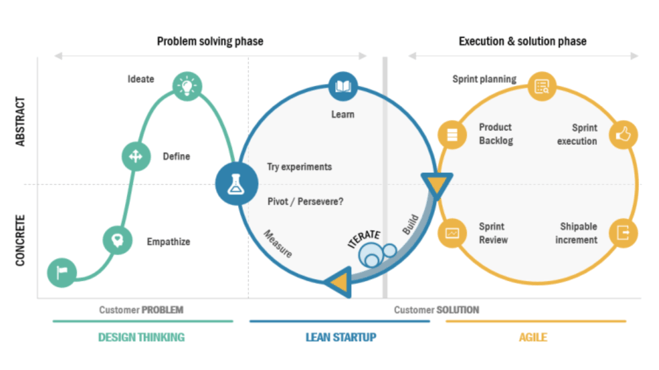Ana Sousa, UX-UI designer at Codurance, gives us an overview of Lean User Experience, the methodology, its main characteristics and challenges.
Lean User Experience (UX) is an approach based on iterative product design taking into account end-user feedback to create an experience that delivers real value. The concept comes from Steve Blank, a Silicon Valley entrepreneur, who developed a product validation methodology based on customer development that consists of finding out if a product satisfies the needs or desires of users.
Lean UX is based on 3 pillars:
- Design Thinking. Finding solutions through collaborative work
- Lean startup. Proposals, feedback and adjustments.
- Agile Software Development. Deliver value quickly and regularly.
Design Thinking seeks to empathise with the user's frustrations and motivations, then define the problem and offer the first possible solutions. Next, Lean Startup focuses on how to create, develop and test solutions through metrics, and finally Agile focuses on how to create and scale solutions through continuous value delivery.

Lean UX principles
Here are some principles that teams must take into account for this methodology to be truly effective:
- Have cross-functional, problem-focused teams. In other words, everyone should bring knowledge and efficiency to the team.
- Small teams (no more than 10 people) allow a better flow of communication and to keep abreast of changes.
- Progress equals results. The functions that are launched in the market must give good results, otherwise you should consider changing them.
- The focus should always be on the problem and solution.
- Eliminate waste. Cut anything that does not contribute to better results, e.g. long meetings, features outside the MVP, excessive documentation, etc.
- Have small batches. Work only with the designs needed to move a stream forward and avoid wasting time.
- Work with continuous, user-centric discovery. Constantly validate solutions with stakeholders and users through interviews, questionnaires, A/B testing, etc.
- There are no heroes or single stars, the focus is on users. Lean UX advocates team mentality and continuous collaboration.
- Externalisation of work and permission to make mistakes.
- Doing is prioritised over analysing. It is more valuable to create a first version of an idea than to explore the reasons for that idea indefinitely.
- Don't have excessive deliverables. Progress will always depend on the results and not on the documentation that is delivered.
What Lean brings to UX and design is the ability to listen to users and, if the path is not the right one, modify it to meet their real needs.
- Ana Sousa, UX-UI designer at Codurance
Collaborative design, MVP and feedback
The technical team and the design team should collaborate from the beginning of a project so that they all understand the objectives and challenges they face. This collaborative design allows both teams to have a shared vision and to contribute knowledge from different areas.
For example, to boost this trust between teams, at Codurance we hold sessions between a product owner, a craftsperson and a designer. "This allows us to create wireframes or brainstorm possible solutions and even ask questions about viable features, execution times and more technical knowledge of each step," says Ana.
Then, to determine the feasibility of solutions we will create the minimum possible elements/minimum viable product (MVP). It is important to find the solutions we want to invest our time in as early as possible and let stakeholders and users test them and, with their feedback, develop them further.
This feedback should be constant and the whole team should be involved. There are some techniques that can be used for analysis such as: usability tests with wireframe or prototypes, surveys, usage statistics, A/B tests, etc.
Integration of Lean UX and Agile development
Ana explains that it is important for the process that the whole team works within Agile Software Development methodologies (scrum or canva for example), as this allows the team to be highly collaborative and will help them when writing and prioritising user stories.
Constant technical validation of the solutions is also necessary, so that the technical team can contribute their ideas on the feasibility of the project. Ideally, frequent sessions should be held to react to the sprints, but when this is not possible, it is necessary to find a balance but not leave this review to the final delivery of the MVP, as it is very likely that changes will have to be made.
Lean UX Challenges
We have seen that Lean UX is a mindset and a process, but it is also a management method. Therefore, to get the maximum benefit, some organisational changes are necessary.
- Designers must open up the design process to others to break down silos within the team and allow for the exchange of ideas.
- Commitment to continuous improvement. A user orientation involves not only working on code, but also improving interfaces and usability.
- Openness and focus on results. For Lean UX to work, all team members must assume their role with commitment and responsibility.
The essence of the Lean UX approach is to design only what is necessary, deliver quickly and get feedback from stakeholders and users. With that information, iterate the product and generate metrics to measure satisfaction. It is also essential to focus on collaboration, both within the team and with the customer.
If you want to check more blogs about methodologies and team management, visit our Insights. And also check our next events and join us.




